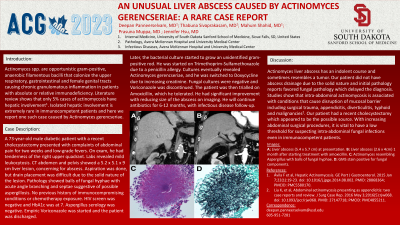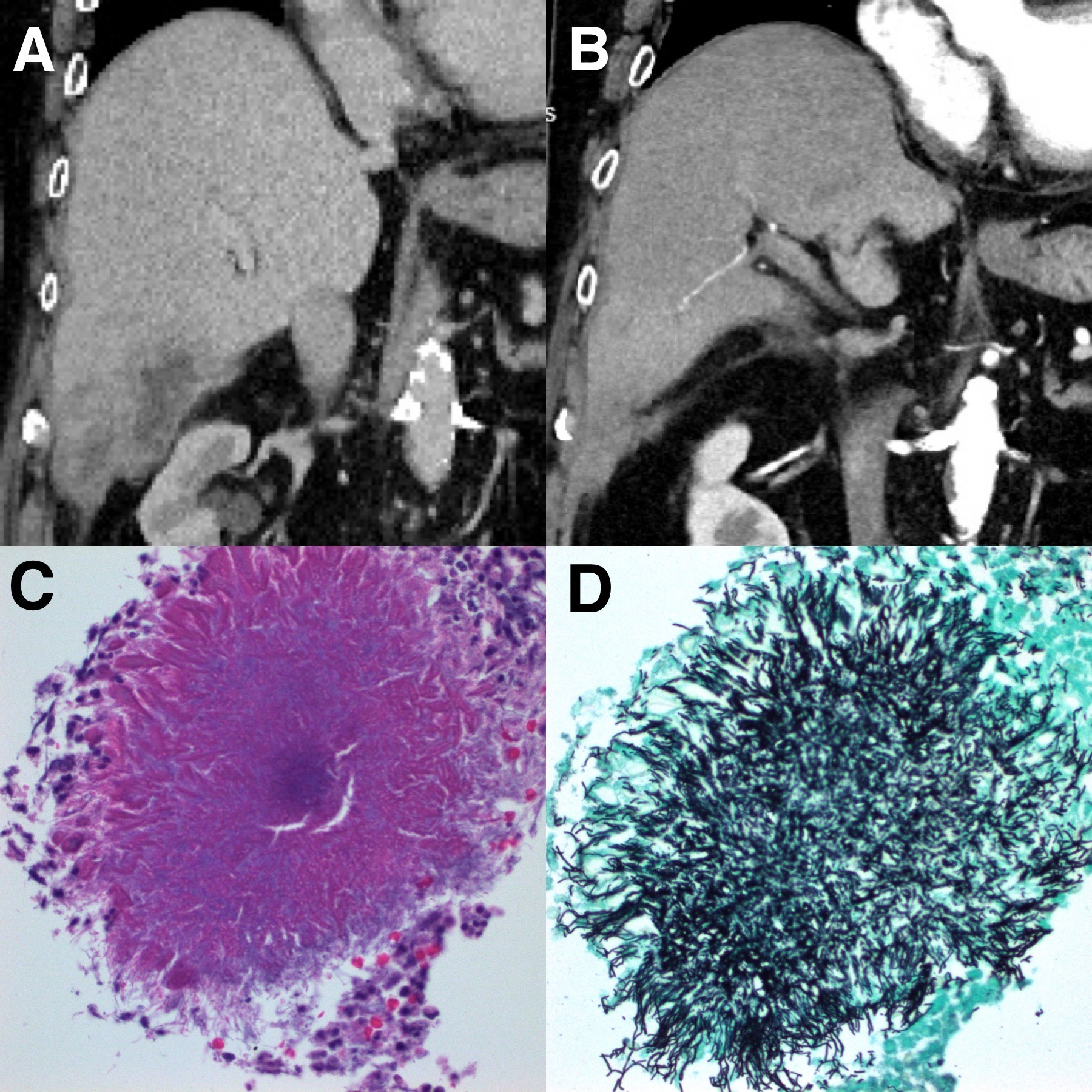Tuesday Poster Session
Category: Liver
P3967 - An Unusual Liver Abscess Caused by Actinomyces gerencseriae: A Rare Case Report
Tuesday, October 24, 2023
10:30 AM - 4:00 PM PT
Location: Exhibit Hall

Has Audio

Deepan Panneerselvam, MD
University of South Dakota Sanford School of Medicine
Sioux Falls, SD
Presenting Author(s)
Deepan Panneerselvam, MD, Thabuna Sivaprakasam, MD, Mahum Shahid, MD, Prasuna Muppa, MD, Jennifer Hsu, MD
University of South Dakota Sanford School of Medicine, Sioux Falls, SD
Introduction: Actinomyces spp. are opportunistic gram-positive, anaerobic filamentous bacilli that colonize the upper respiratory, gastrointestinal and female genital tracts causing chronic granulomatous inflammation in patients with absolute or relative immunodeficiency. Literature review shows that only 5% cases of actinomycosis have hepatic involvement. Isolated hepatic involvement is extremely rare in immunocompetent patients and here we report one such case caused by Actinomyces gerencseriae.
Case Description/Methods: A 73-year-old male diabetic patient with a recent cholecystectomy presented with complaints of abdominal pain for two weeks and low-grade fevers. On exam, he had tenderness of the right upper quadrant. Labs revealed mild leukocytosis. CT abdomen and pelvis showed a 5.2 x 5.1 x 9 cm liver lesion, concerning for abscess. Aspiration was done, but drain placement was difficult due to the solid nature of the lesion. Pathology showed balls of fungal hyphae with acute angle branching and septae suggestive of possible aspergillosis. No previous history of immunocompromising conditions or chemotherapy exposure present. HIV screen was negative and HbA1c was at 7. Aspergillus serology was negative. Empiric Voriconazole was started and the patient was discharged. Later, the bacterial culture started to grow an unidentified gram-positive rod. He was started on Trimethoprim-Sulfamethoxazole due to a penicillin allergy. Cultures eventually revealed Actinomyces gerensceriae, and he was switched to Doxycycline due to increasing creatinine. Fungal cultures were negative and Voriconazole was discontinued. The patient was then trialed on Amoxicillin, which he tolerated. He had significant improvement with reducing size of the abscess on imaging. He will continue antibiotics for 6-12 months, with infectious disease follow-up.
Discussion: Actinomyces liver abscess has an indolent course and sometimes resembles a tumor. Our patient did not have abscess drainage due to the solid nature and initial pathology reports favored fungal pathology which delayed the diagnosis. Studies show that intra-abdominal actinomycosis is associated with conditions that cause disruption of mucosal barrier including surgical trauma, appendicitis, diverticulitis, typhoid and malignancies. Our patient had a recent cholecystectomy which appeared to be the possible source. With increasing abdominal surgical procedures, it is vital to have a low threshold for suspecting intra-abdominal fungal infections even in immunocompetent patients.

Disclosures:
Deepan Panneerselvam, MD, Thabuna Sivaprakasam, MD, Mahum Shahid, MD, Prasuna Muppa, MD, Jennifer Hsu, MD. P3967 - An Unusual Liver Abscess Caused by Actinomyces gerencseriae: A Rare Case Report, ACG 2023 Annual Scientific Meeting Abstracts. Vancouver, BC, Canada: American College of Gastroenterology.
University of South Dakota Sanford School of Medicine, Sioux Falls, SD
Introduction: Actinomyces spp. are opportunistic gram-positive, anaerobic filamentous bacilli that colonize the upper respiratory, gastrointestinal and female genital tracts causing chronic granulomatous inflammation in patients with absolute or relative immunodeficiency. Literature review shows that only 5% cases of actinomycosis have hepatic involvement. Isolated hepatic involvement is extremely rare in immunocompetent patients and here we report one such case caused by Actinomyces gerencseriae.
Case Description/Methods: A 73-year-old male diabetic patient with a recent cholecystectomy presented with complaints of abdominal pain for two weeks and low-grade fevers. On exam, he had tenderness of the right upper quadrant. Labs revealed mild leukocytosis. CT abdomen and pelvis showed a 5.2 x 5.1 x 9 cm liver lesion, concerning for abscess. Aspiration was done, but drain placement was difficult due to the solid nature of the lesion. Pathology showed balls of fungal hyphae with acute angle branching and septae suggestive of possible aspergillosis. No previous history of immunocompromising conditions or chemotherapy exposure present. HIV screen was negative and HbA1c was at 7. Aspergillus serology was negative. Empiric Voriconazole was started and the patient was discharged. Later, the bacterial culture started to grow an unidentified gram-positive rod. He was started on Trimethoprim-Sulfamethoxazole due to a penicillin allergy. Cultures eventually revealed Actinomyces gerensceriae, and he was switched to Doxycycline due to increasing creatinine. Fungal cultures were negative and Voriconazole was discontinued. The patient was then trialed on Amoxicillin, which he tolerated. He had significant improvement with reducing size of the abscess on imaging. He will continue antibiotics for 6-12 months, with infectious disease follow-up.
Discussion: Actinomyces liver abscess has an indolent course and sometimes resembles a tumor. Our patient did not have abscess drainage due to the solid nature and initial pathology reports favored fungal pathology which delayed the diagnosis. Studies show that intra-abdominal actinomycosis is associated with conditions that cause disruption of mucosal barrier including surgical trauma, appendicitis, diverticulitis, typhoid and malignancies. Our patient had a recent cholecystectomy which appeared to be the possible source. With increasing abdominal surgical procedures, it is vital to have a low threshold for suspecting intra-abdominal fungal infections even in immunocompetent patients.

Figure: A: Liver abscess (5.4 x 5.7 cm) at presentation. B: Liver abscess (2.6 x 4cm) 1 month after starting treatment with amoxicillin.
C: Actinomyces resembling Aspergillus with balls of fungal hyphae. D: GMS stain positive for fungal components.
C: Actinomyces resembling Aspergillus with balls of fungal hyphae. D: GMS stain positive for fungal components.
Disclosures:
Deepan Panneerselvam indicated no relevant financial relationships.
Thabuna Sivaprakasam indicated no relevant financial relationships.
Mahum Shahid indicated no relevant financial relationships.
Prasuna Muppa indicated no relevant financial relationships.
Jennifer Hsu indicated no relevant financial relationships.
Deepan Panneerselvam, MD, Thabuna Sivaprakasam, MD, Mahum Shahid, MD, Prasuna Muppa, MD, Jennifer Hsu, MD. P3967 - An Unusual Liver Abscess Caused by Actinomyces gerencseriae: A Rare Case Report, ACG 2023 Annual Scientific Meeting Abstracts. Vancouver, BC, Canada: American College of Gastroenterology.
